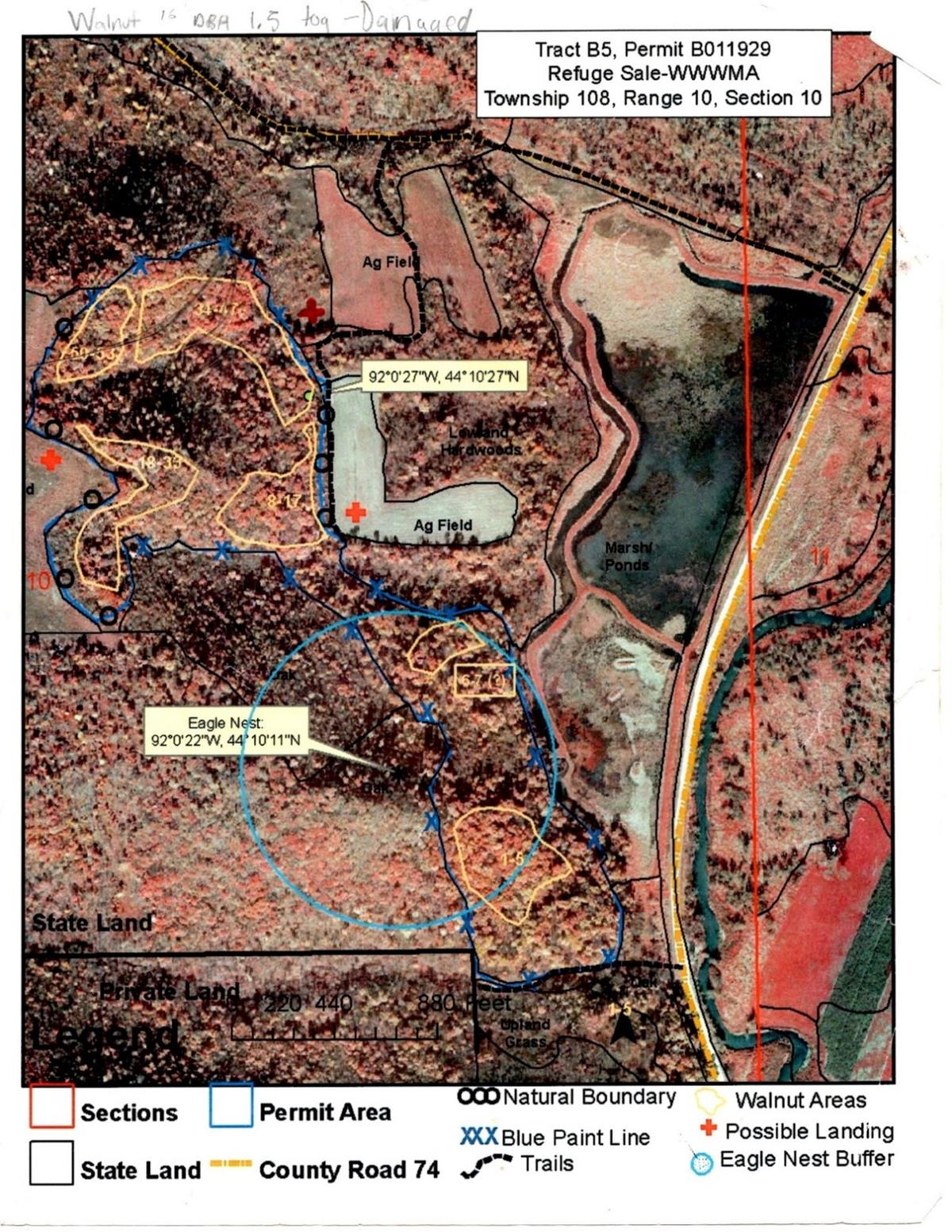Overview
One unique method for hardwood regeneration in southeastern Minnesota is pre-harvest “underplanting”. Seedlings are planted 1 to 3 years before a harvest to give them a chance to become established before a site is opened up to full sunlight post-harvest.
This study documents early results of an underplanting prescription to regenerate a mature oak stand to a young stand of similar composition. It also provides an opportunity to follow progress in future years by updating the study with stand condition data gathered in future years.
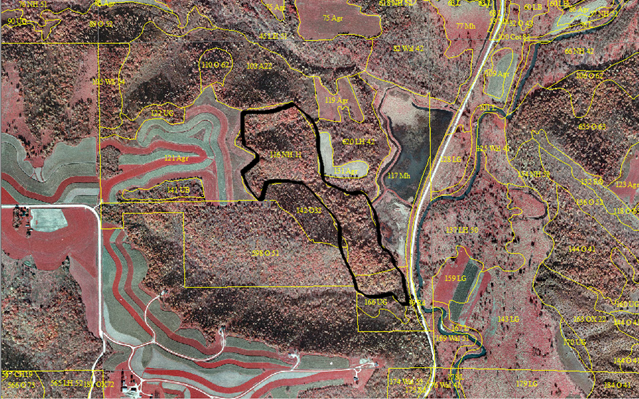
Figure 1: Color infrared aerial photograph of case study site (outlined in black) and surrounding area.
Silviculture Objectives
Background on typical oak regeneration through pre-harvest underplanting prescription:
- Seedlings have been planted prior to harvest (instead of after) because:
- They become established for a year or two, helping them be better able to grow and compete with other vegetation after exposure of the site to full sunlight post-harvest.
- It is extremely difficult and expensive to plant seedlings after a harvest, with heavy amounts of slash on the ground.
- Other species such as black walnut are mixed into plantings as appropriate for the site.
- Most often, the harvest prescription has been a clearcut with reserves, although there have also been some shelterwood harvests.
- Damage to underplanted seedlings during harvesting activity is usually modest. The young stems are pretty flexible and most often survive being run over by a skidder by bending but not breaking. Those that do break off generally resprout and exhibit the rapid juvenile growth associated with sprout origin stems.
Pre-treatment stand description and condition
Pre-treatment species composition
Table 1: 2012 Timber Sale Appraisal Species and Volume Estimates for the 54 acre stand.
Species | Quantity (MBF) |
Red Oak | 120.1 |
Black Oak | 25.4 |
White Oak | 38.2 |
Bur Oak | 6.1 |
Black Walnut | 11.1 |
American Elm | 3.3 |
Basswood | 1.9 |
Hackberry | 1.1 |
Ash | .8 |
Black Cherry | .5 |
Cottonwood | .5 |
Sugar Maple | .3 |
Aspen | .2 |
Total | 209.5 |
Landowner objectives/situation
Wildlife Management Areas (WMAs) are part of Minnesota's outdoor recreation system and are established to protect those lands and waters that have a high potential for wildlife production, public hunting, trapping, fishing, and other compatible recreational uses. They are the backbone of the DNR's wildlife management efforts in Minnesota and are key to protecting wildlife habitat for future generations by providing Minnesotans with opportunities for hunting, fishing, and wildlife watching, and by promoting important wildlife-based tourism in the state. Source: Whitewater Wildlife Management Area Master Plan
The specific Minnesota DNR objective for mature oak forest type acres on Southern Dry-Mesic Oak Forest native plant community sites was to regenerate them to young forest of similar composition.
Silviculture prescription
The following series of treatments were implemented:
Treatment | Date | Description | Acres Treated |
Timber Appraisal and Silvicultural Assessment | Summer and fall 2012 | Timber was appraised for sale, and the stand was assessed to determine a silvicultural strategy. This included a survey of advance regeneration. | NA |
Underplanting | Spring, 2012 | Bareroot seedlings were hand planted 1 to 2 growing seasons before harvest at 856 trees per acre to give them a chance to become established before the site is opened up to full sunlight post- harvest.
Species and total seedlings planted:
| 54 |
Clearcut with Reserves Harvest | October 2012 through August 2013 | Clearcut with reserves harvest. | 54 |
Post-sale killing of elm, ironwood and basswood | Summer 2014 | Competing boxelder, elm and ironwood trees were killed by girdling with a chainsaw, and applying Tordon herbicide to the girdle wound. | 54 |
What actually happened during the treatment
The treatment was implemented exactly as prescribed. The harvest system was hand-felling with cable skidding. The eagle's nest was found during a standard pre-appraisal review with the following notes on the timber appraisal:
There is an eagle nest with a 660 foot buffer, as indicated on the timber sale map. No sale operations can take place within the buffer within the nesting season (February through July). Sale operations may take place outside the buffer during the nesting season.
Post-treatment assessment
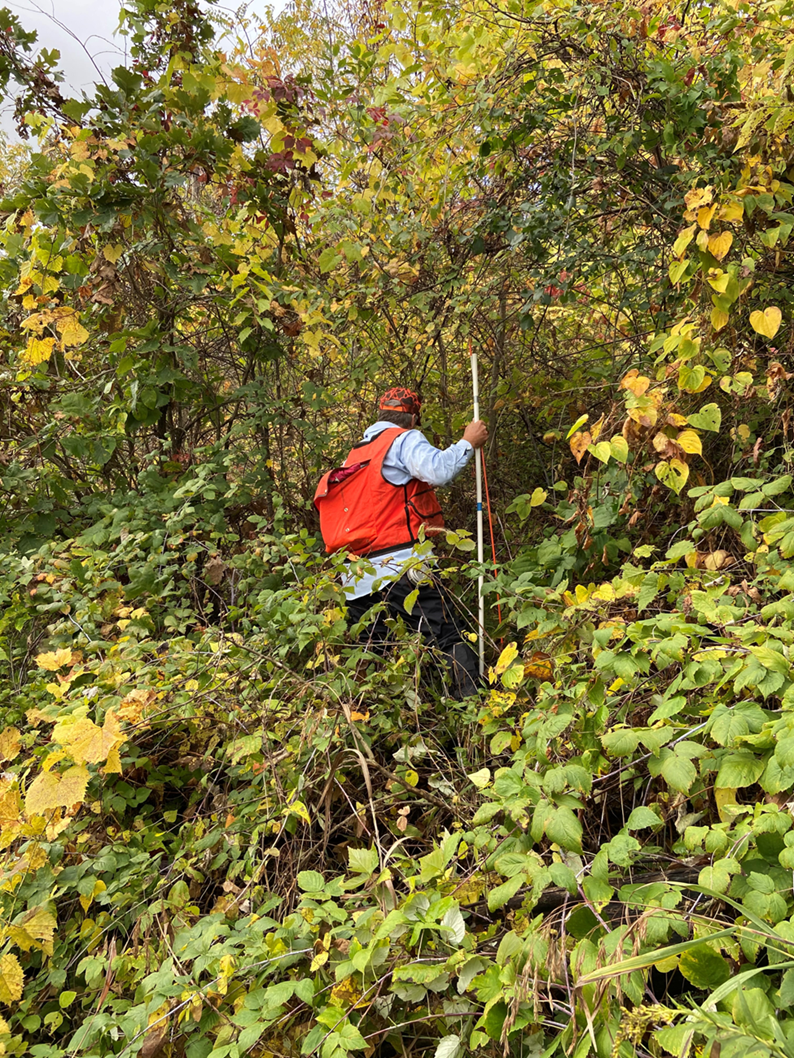
Figure 2: Keith Jacobson gathering regeneration data among heavy competition, summer 2020
Regeneration
The silvicultural prescription of pre-harvest underplanting, a clearcut with reserves harvest, and killing of competing trees after harvest has resulted in a young stand consisting of mixed hardwood regeneration as of 2020.
8 years after initial treatment, there is a mixture of desirable hardwood regeneration (Table 3). A fair number of these seedling and sapling stems are above deer browse, with many clearly at “free to grow” status.
Desirable hardwood species regeneration includes red oak, black cherry, basswood, hackberry, black walnut, shagbark hickory, and (on a small portion of the site) sugar maple. Other species present include elm, bitternut hickory, ash, trembling aspen, paper birch, black locust and butternut.
While there is an oak component in portions of the stand, it is not nearly as abundant or well-distributed as we would have liked
It is important to note that while this is now on its way to becoming a healthy mixed central hardwoods stand, the oak component is considerably less than we were hoping for. Early post-planting regeneration data from 2013 (Table 4) showed only a modest oak regeneration presence, and notes indicated that survival of the planted oak seedlings was poor. Not surprisingly, 2020 regeneration data showed a similar condition of only a small amount of oak regeneration. We found most of the very limited oak regeneration on somewhat drier knobs.
Land managers will continue to monitor and assess the site over time. If desired, they should have options to adjust species mix through future crop tree release/thinning treatments.
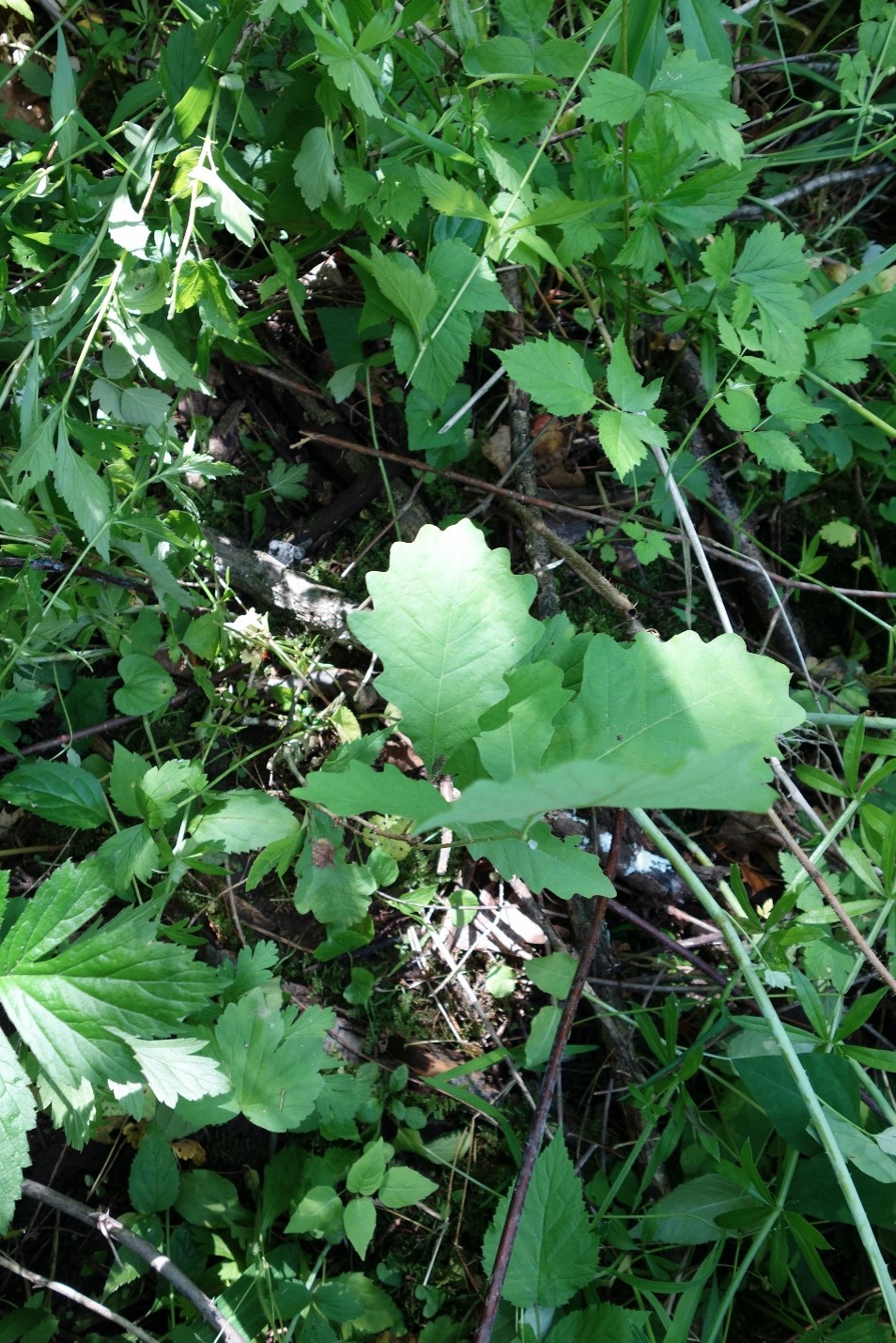
Figure 3: One of the very few surviving planted oaks we found as of summer 2020
Possible causes of the less-than-desired oak regeneration may have included:
- It is probable that dry weather after planting was a major factor impacting poor seedling survival. 2012 was quite dry compared to the 30 year average (Table 2).
Table 2: January-September Monthly Precipitation 2012, Compared To 30-Year Average
Jan | Feb | Mar | Apr | May | Jun | Jul | Aug | Sep | |
2012 | 0.85 | 1.95 | 1.31 | 3.06 | 3.77 | 3.72 | 2.35 | 2.87 | 1.44 |
1991-2020 Average | 1.02 | 1.09 | 1.98 | 3.48 | 4.57 | 5.24 | 4.02 | 4.59 | 3.65 |
- Lack of early release from competing vegetation. The planted and natural seedlings oak that did survive dry 2012 weather would have benefitted from early release from vegetative competition.
- Deer browse is also often a factor that has a negative impact on oak seedling recruitment to larger size classes.
Table 3: Regeneration Summary: Trees/Acre and Plot Frequency by Species and Size Class in 2020 (8 growing seasons after initial treatment). Underplanted species in bold font.
Size Class | < 1’ tall | ≥1’ tall and < 1” DBH | 1” to 3” DBH | 3” to 5” DBH | ||||
Species | Stems/ Acre | Freq | Stems/ Acre | Freq | Stems/ Acre | Freq | Stems/ Acre | Freq |
Ash | 53 | 5% | 153 | 5% | 0 | 0% | 0 | 0% |
Black Cherry | 105 | 5% | 158 | 11% | 105 | 16% | 11 | 5% |
Black Walnut | 53 | 5% | 263 | 16% | 53 | 11% | 0 | 0% |
Bur Oak | 0 | 0% | 53 | 5% | 0 | 0% | 0 | 0% |
Butternut | 0 | 0% | 0 | 0% | 0 | 0% | 16 | 5% |
Elm | 1368 | 47% | 526 | 32% | 0 | 0% | 26 | 11% |
Hackberry | 0 | 0% | 105 | 11% | 105 | 16% | 0 | 0% |
Ironwood | 53 | 5% | 53 | 5% | 0 | 0% | 0 | 0% |
Red Oak (Seedling) | 211 | 16% | 0 | 0% | 26 | 5% | 11 | 5% |
Sugar Maple | 158 | 11% | 0 | 0% | 26 | 5% | 0 | 0% |
White Oak | 158 | 11% | 0 | 0% | 0 | 0% | 0 | 0% |
Total Stems/Acre | 2159 |
| 1311 |
| 315 |
| 64 |
|
Table 4: July 2013 regeneration check crop trees by species and size class (1.5 growing seasons after initial treatment). Underplanted species in bold font.
Species | Stems/Acre | Avg. Height (Feet) | Stocking | Damage |
Aspen | 11 | 1 | 11% | None |
Basswood | 9 | 1 | 5% | None |
Black Cherry | 55 | 1 | 33% | None |
Black Walnut | 44 | 1 | 44% | Deer browse- 5% |
Hackberry | 66 | 1 | 44% | None |
Red Oak | 88 | 1 | 44% | Deer browse – 10% |
White Oak | 33 | 1 | 28% | Deer browse – 10% |
Total | 306 |
|
|
|
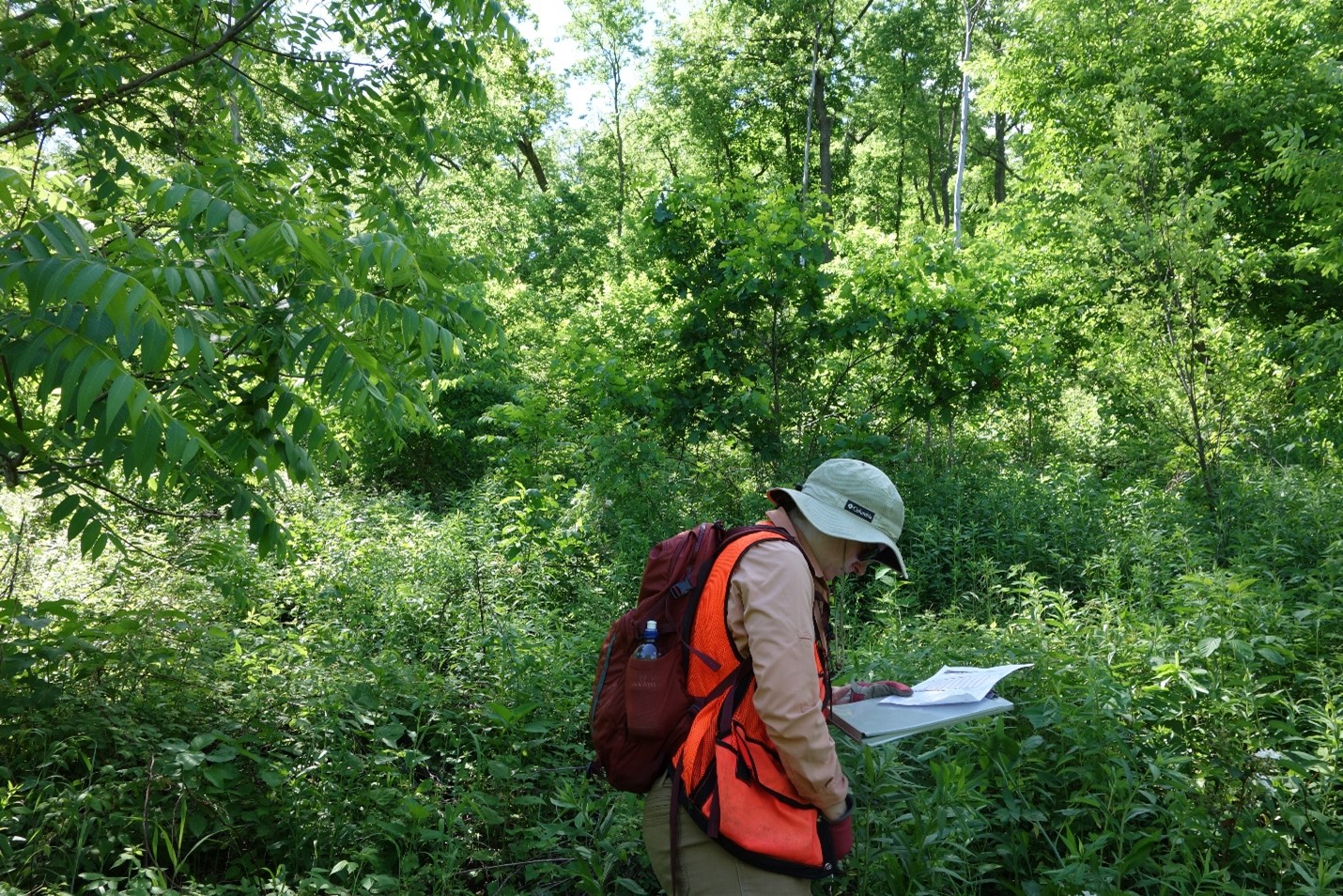
Figure 4: Michelle Martin gathering regeneration data in a portion of the stand with black walnut regeneration, summer 2020
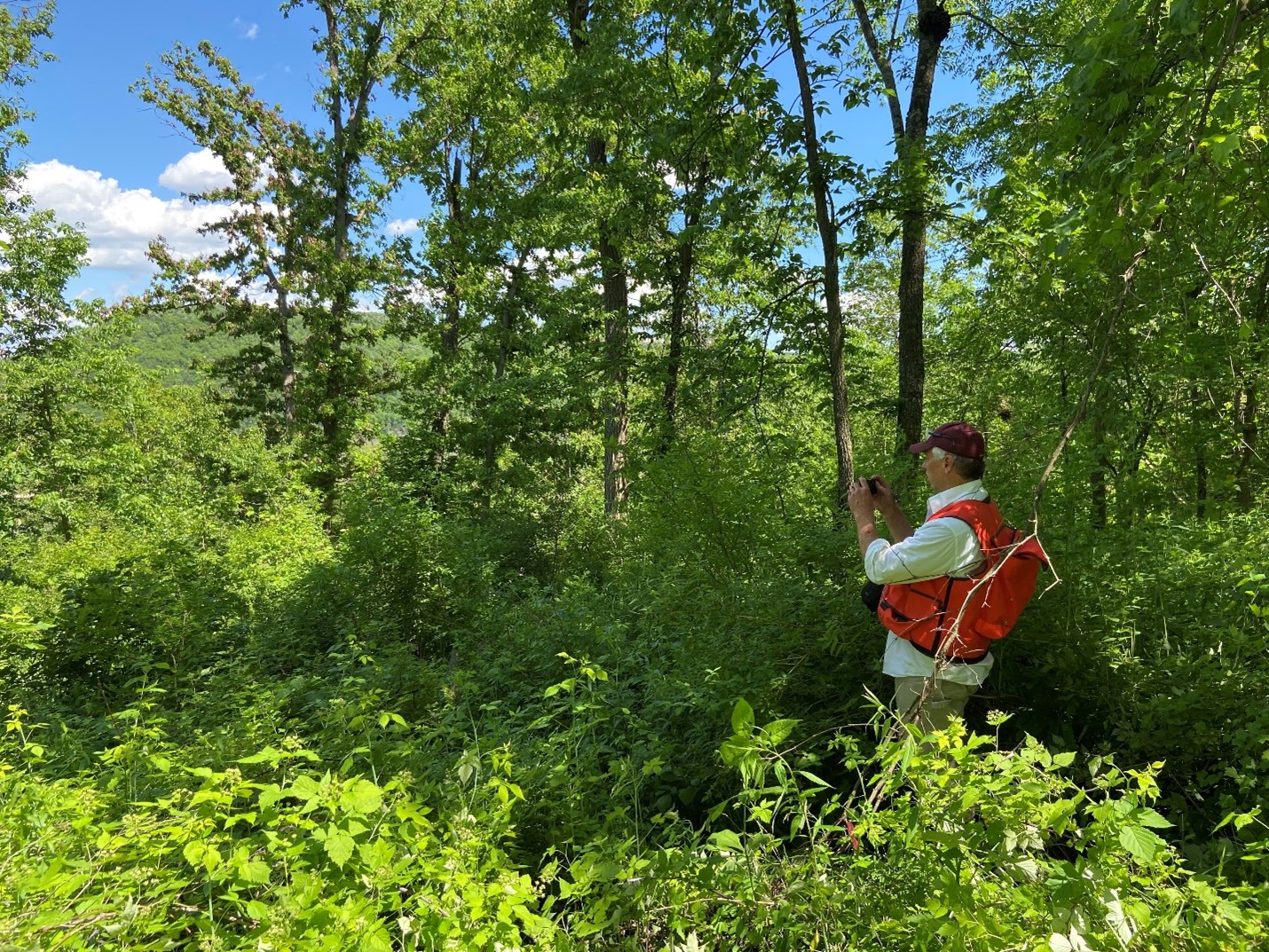
Figure 5: Keith Jacobson gathering regeneration data among heavy competition, summer 2020
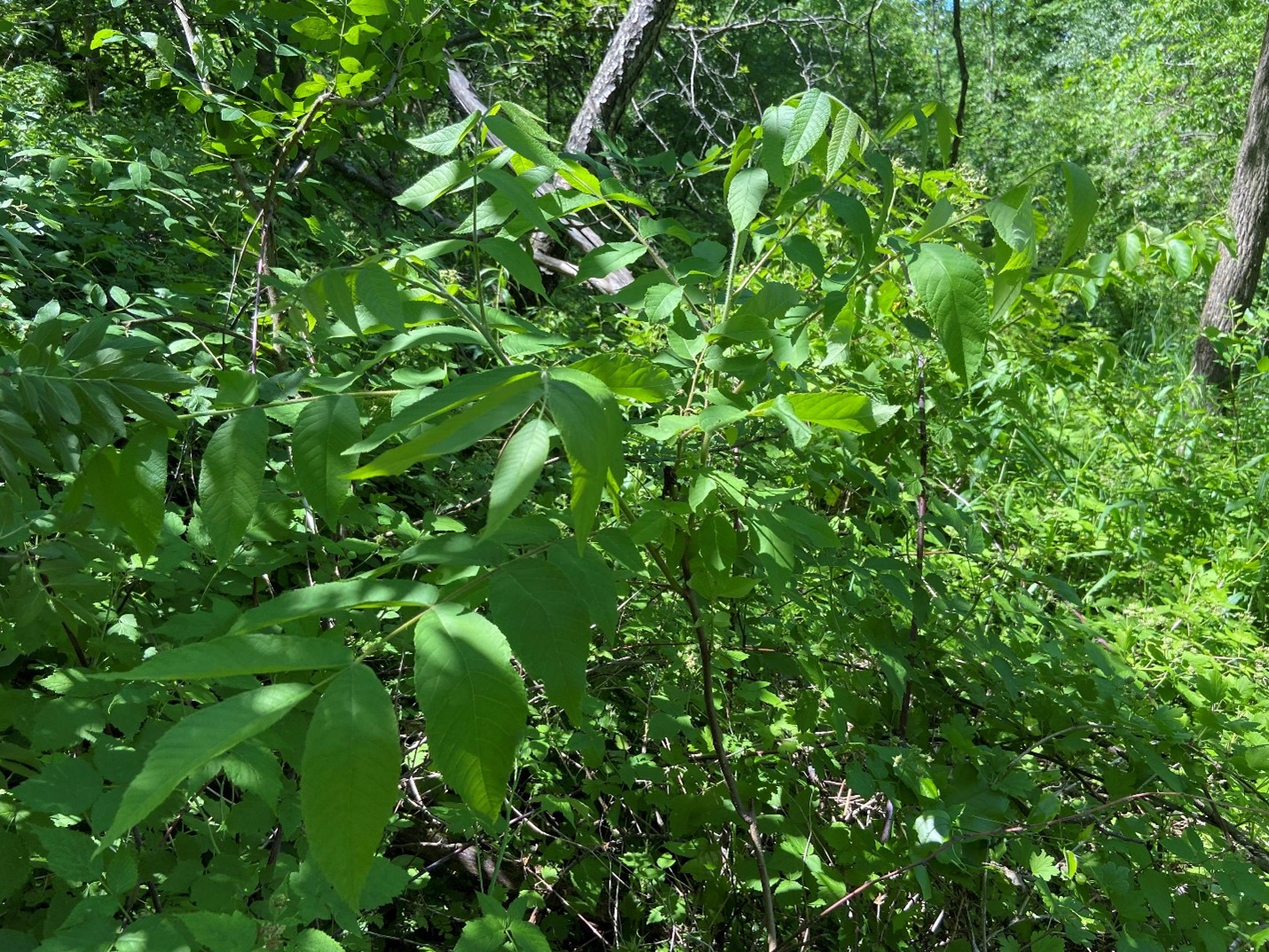
Figure 6: A stem of black walnut regeneration among heavy competition, summer 2020
Residual overstory trees
We were most interested in regeneration for this study, so residual overstory trees are not a major part of the story here. However, we want to include data on residual overstory trees to give a full picture of site conditions. The data in Table 5 shows basal area of residual tree stems in the study area.
Table 5: Basal Area (ft2/ac.) of Trees > 5” DBH by Species and Diameter Class in 2020
| Diameter Class |
| |||
Species | 5-10” DBH | 10-15” DBH | 15-20” DBH | >20” DBH | Total |
Aspen | 0.5 | 0.0 | 1.6 | 0.0 | 2.1 |
Basswood | 0.5 | 0.5 | 1.6 | 0.0 | 2.6 |
Black Cherry | 2.6 | 0.0 | 0.0 | 0.0 | 2.6 |
Black Walnut | 2.1 | 1.6 | 3.2 | 0.0 | 6.9 |
Bur Oak | 0.0 | 2.6 | 2.1 | 1.6 | 6.3 |
Hackberry | 3.7 | 1.1 | 0.0 | 0.0 | 4.8 |
Paper Birch | 0.5 | 0.0 | 0.0 | 0.0 | 0.5 |
Red Oak | 1.1 | 0.5 | 3.7 | 2.6 | 7.9 |
White Oak | 0.0 | 0.5 | 0.5 | 1.6 | 2.6 |
Total | 11.0 | 6.8 | 12.7 | 5.8 | 36.3 |
Understory Plants
We noted a wide variety of herbaceous plants, includingMissouri gooseberry, white snakeroot, bloodroot, enchanter’s nightshade, jack-in-the-pulpit, lady fern, pointed leaved tick trefoil, honewort, jumpseed, violet species, perfoliate-leaved horse- gentian, and maidenhair fern.
Invasives
Buckthorn: We found buckthorn on 36% of plots as of 2020. See Table 6.
Table 6: Buckthorn stems/acre and plot frequency by size class in 2020
Size Class | < 1’ tall
| ≥1’ tall and < 1” DBH
| 1” to 3” DBH
| 3” to 5” DBH | ||||
Species | Stems/ Acre | Freq | Stems/ Acre | Freq | Stems/ Acre | Freq | Stems/ Acre | Freq |
Buckthorn | 182 | 9% | 1,273 | 27% | 136 | 18% | 0 | 0.0% |
Invasives will continue to be monitored and may be treated if needed.
Plans for Future Treatments
Monitor the stand through periodic inventory surveys.
Costs and economic considerations
Costs
Underplant seedlings pre-harvest: $ 438/ac.
Timber sale setup and administration: $ 100/ac
Post-sale killing of competing undesirable trees 1990: $ 128/ac (estimated)
TOTAL: $ 666/ac
Revenue
Timber harvest $ 1,372/ac
TOTAL: $ 1,372/ac.
Other notes
We had review and editing help from MNDNR Silviculture Program Consultant Mike Reinikainen.
This case study was developed with support from the United States Department of Agriculture's National Institute for Food and Agriculture, Renewable Resources Extension Act. Project #2021-46401-35956, principal investigator Eli Sagor, University of Minnesota.
Summary
The silvicultural prescription of pre-harvest underplanting, a clearcut with reserves harvest, and killing of competing trees after harvest has resulted in a young stand consisting of mixed hardwood regeneration as of 2020
8 years after initial treatment, there was a mixture of desirable hardwood regeneration. A fair number of these seedling and sapling stems are above deer browse, with many clearly at “free to grow” status.
Desirable hardwood species regeneration includes red oak, black cherry, basswood, hackberry, black walnut, shagbark hickory, and (on a small portion of the site) sugar maple. Other species present include elm, bitternut hickory, ash, trembling aspen, paper birch, black locust and butternut.
While there is an oak component in portions of the stand, it is not nearly as abundant or well-distributed as we would have liked
While this is now on its way to becoming a healthy mixed central hardwoods stand, the oak component is considerably less than we were hoping for. Early post-planting regeneration data in 2013 showed only a modest oak regeneration presence, and notes indicate that survival of the planted oak seedlings was poor. Not surprisingly, 2020 regeneration data shows a similar condition of only a small amount of oak regeneration.
Land managers will continue to monitor and assess the site over time. If desired, they should have options to adjust species mix through future crop tree release/thinning treatments.
Causes of the less-than-desired oak regeneration may have included:
- It is probable that dry weather before and after planting was a major factor impacting poor seedling survival. 2012 was quite dry compared to the 30 year average.
- Lack of early release from competing vegetation.
- Deer browse.
